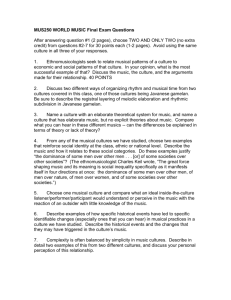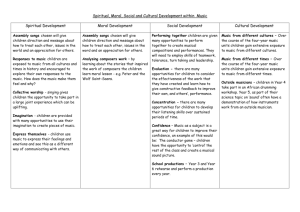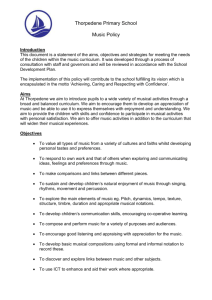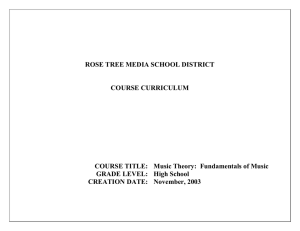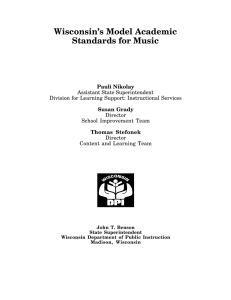Grade 5 Music
advertisement
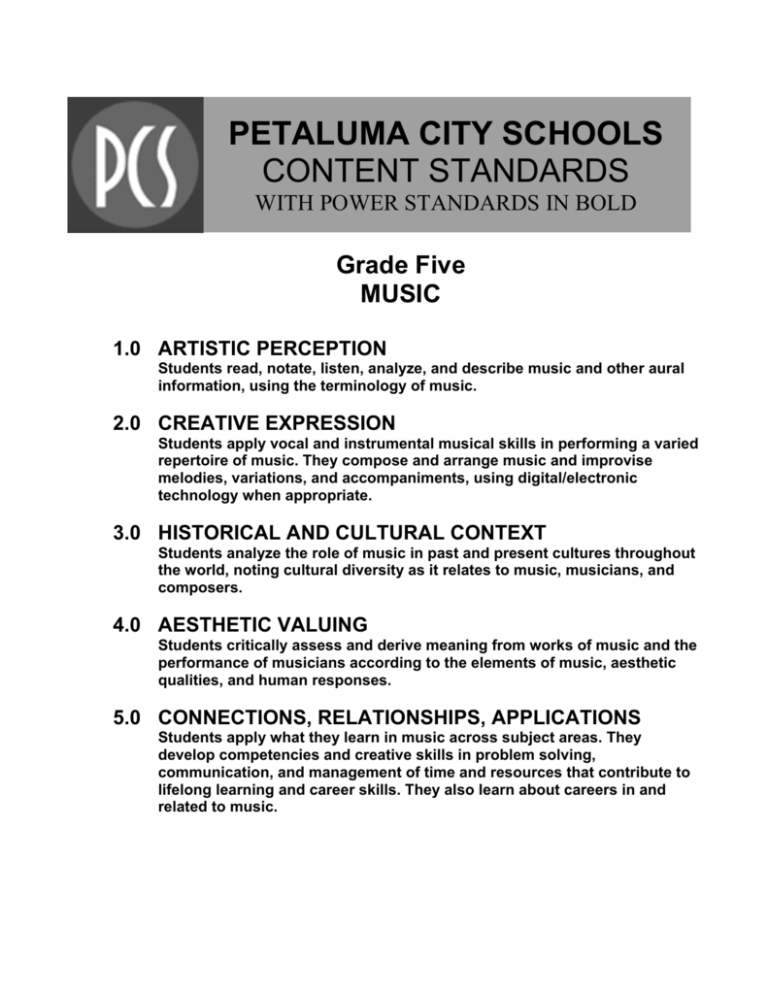
PETALUMA CITY SCHOOLS CONTENT STANDARDS WITH POWER STANDARDS IN BOLD Grade Five MUSIC 1.0 ARTISTIC PERCEPTION Students read, notate, listen, analyze, and describe music and other aural information, using the terminology of music. 2.0 CREATIVE EXPRESSION Students apply vocal and instrumental musical skills in performing a varied repertoire of music. They compose and arrange music and improvise melodies, variations, and accompaniments, using digital/electronic technology when appropriate. 3.0 HISTORICAL AND CULTURAL CONTEXT Students analyze the role of music in past and present cultures throughout the world, noting cultural diversity as it relates to music, musicians, and composers. 4.0 AESTHETIC VALUING Students critically assess and derive meaning from works of music and the performance of musicians according to the elements of music, aesthetic qualities, and human responses. 5.0 CONNECTIONS, RELATIONSHIPS, APPLICATIONS Students apply what they learn in music across subject areas. They develop competencies and creative skills in problem solving, communication, and management of time and resources that contribute to lifelong learning and career skills. They also learn about careers in and related to music. The bolded standards within this document are being proposed for priority teaching so that all students receive an equitable, aligned curriculum preparing them for success in school and in life. GRADE FIVE MUSIC Visual and Performing Arts: Music Content Standards ARTISTIC PERCEPTION • 1.0 Processing, Analyzing, and Responding to Sensory Information Through the Language and Skills Unique to Music: Students read, notate, listen, analyze, and describe music and other aural information, using the terminology of music. Read and Notate Music (B) 1.1 Read, write, and perform simple melodic notation in treble clef in major and minor keys. (B) 1.2 Read, write, and perform major and minor scales. 1.3 Read, write, and perform rhythmic notation, including quarter-note triplets and tied syncopation. Listen to, Analyze, and Describe Music 1.4 Analyze the use of music elements in aural examples from various genres and cultures. 1.5 Identify vocal and instrumental ensembles from a variety of genres and cultures. 1.6 Identify and describe music forms, including theme and variations and twelve-bar blues. CREATIVE EXPRESSION • 2.0 Creating, Performing, and Participating in Music: Students apply vocal and instrumental musical skills in performing a varied repertoire of music. They compose and arrange music and improvise melodies, variations, and accompaniments, using digital/electronic technology when appropriate. Apply Vocal and Instrumental Skills (C) 2.1 Sing a varied repertoire of music, including rounds, descants, and songs with ostinatos and songs in two-part harmony, by oneself and with others. (B) 2.2 Use classroom instruments to play melodies and accompaniments from a varied repertoire of music from diverse cultures, including rounds, descants, and ostinatos and two-part harmony, by oneself and with others. Compose, Arrange, and Improvise 2.3 Compose, improvise, and perform basic rhythmic, melodic, and chordal patterns independently on classroom instruments. HISTORICAL AND CULTURAL CONTEXT • 3.0 Understanding the Historical Contributions and Cultural Dimensions of Music: Students analyze the role of music in past and present cultures throughout the world, noting cultural diversity as it relates to music, musicians, and composers. Role of Music 3.1 Describe the social functions of a variety of musical forms from various cultures and time periods (e.g., folk songs, dances). Diversity of Music 3.2 Identify different or similar uses of musical elements in music from diverse cultures. 3.3 Sing and play music from diverse cultures and time periods. 3.4 Describe the influence of various cultures and historical events on musical forms and styles. 3.5 Describe the influences of various cultures on the music of the United States. AESTHETIC VALUING • 4.0 Responding to, Analyzing, and Making Judgments About Works of Music: Students critically assess and derive meaning from works of music and the performance of musicians according to the elements of music, aesthetic qualities, and human responses. Analyze and Critically Assess 4.1 Identify and analyze differences in tempo and dynamics in contrasting music selections. Derive Meaning (C) 4.2 Develop and apply appropriate criteria to support personal preferences for specific musical works. CONNECTIONS, RELATIONSHIPS, APPLICATIONS • 5.0 Connecting and Applying What Is Learned in Music to Learning in Other Art Forms and Subject Areas and to Careers: Students apply what they learn in music across subject areas. They develop competencies and creative skills in problem solving, communication, and management of time and resources that contribute to lifelong learning and career skills. They also learn about careers in and related to music. Connections and Applications 5.1 Explain the role of music in community events. Careers and Career-Related Skills 5.2 Identify ways in which the music professions are similar to or different from one another. (B): All band students will be able to demonstrate. (C): All chorus students will be able to demonstrate.
